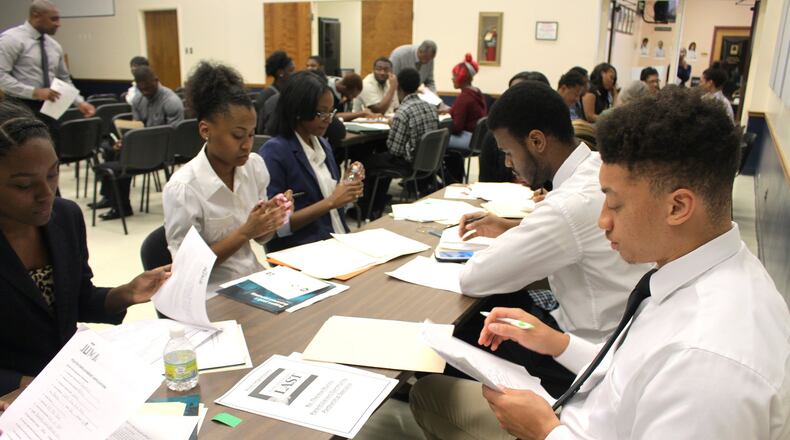Fulton County will have to return hundreds of thousands of dollars in federal funds meant to pay for workforce training programs for county residents, despite putting measures in place three years ago to prevent such a loss of money.
It's the fourth year in a row that Fulton is returning more than $100,000 in workforce development grants that should have paid for job training for unemployed or underemployed residents. The recurring problem, of failing to allocate or spend grant funds, previously led to the county returning $9 million aimed at paying for HIV prevention programs in 2015. All but $1.25 million of the money was later recovered when the Centers for Disease Control and Prevention extended the time Fulton and others had to use their funds.
The federal government allocates the workforce development money to states, which then disburse it to counties in overlapping two-year grants. The counties must decide what to do with most of the money by the end of the first year and must spend it by the second year, or return the bulk of the funds.
This year's loss of funds could have been even worse — more than $2 million — had county officials not scrambled to quickly outsource workforce development dollars, which had to be earmarked by June 30.
In February, in order to better use workforce development money as an incentive to bring business to Fulton, the county moved oversight of the workforce development program from housing and community development to its economic development arm, Select Fulton. That’s when Select Fulton employees discovered the unused grant money and had to quickly take action. The county received $3.6 million in a 2016-2018 federal grant and $3.5 million in a 2017-2019 grant.
“I canceled my whole life,” said Samir Abdullahi, the deputy director of economic development for Select Fulton, of his efforts to find ways to spend the money. “I’ve been living it.”
While the final amount that Fulton left unspent this year won’t be known for more than a month, Mariska Angall, the interim financial systems manager for WorkSource Fulton, said she expected it to be around $200,000. Over the past three years, Fulton has returned more than $535,000 to the state, which then sends the unspent money to other regions to use before the grants expire.
Tracey Bradley, the workforce development division manager who took the job in September, was fired in June, in part for issues managing the grants, County Manager Dick Anderson said. Before him, the director left the job after being on medical leave for a number of months.
But Anderson downplayed the issue, saying he was focused on ensuring the move to Select Fulton meant the money would be put to good use.
“It’s hard for me, as an executive, to get overly exercised about three-tenths of a percent of $82 million,” Anderson said of the money expected to be returned. “If you’re toting water or throwing passes, there’s going to be both incompletions and water spilled. You minimize these things. Less than 1 percent is more than acceptable.”
Robb Pitts, chairman of the Fulton County commission, took a different tack Thursday, when he told volunteer members of the Workforce Development Board that he was “not really happy” with the underspent money, and board members’ lack of oversight.
Of the 19 statewide areas that were granted funds in the 2015-2017 year, only two returned more money than Fulton County — and both received larger grants. Six returned no money, while three returned less than $1,000. In 2013 and 2014, Fulton returned a total of $7.
The grants aren’t administratively easy to manage, said John Helton, the CEO of CobbWorks Inc. and director of WorkSource Cobb. And when the economy is good, as it is now, it’s harder to find people who need training — most would rather go get a job. Still, Helton said, he hasn’t had trouble spending his money.
“It just has to be made a priority,” he said. “There are a lot of opportunities to do really cool things and get things right. There are a lot of opportunities to stumble, as well.”
Brett Manning, the executive director of the Heart of Georgia Altamaha Regional Commission, said he, too, has never had issues spending funds in and around Dublin, where he works.
“There are a lot of people down here who need help,” he said.
To spend the money in the coming year, Fulton County officials signed a $2.05 million contract with ResCare Workforce Services, a Kentucky company that will provide services from job training to career planning, which the county had been handling previously on its own. Abdullahi said the plan had always been for Select Fulton to outsource some services, but he might have taken more time to do so if not for the threat of losing the money.
Anderson said the near-failure was a reminder to have management oversight at all levels. He said a grants council that was created to better manage grants after the HIV money was returned had no knowledge of any problems spending the workforce development grant money.
Tim Birt, a member of the Workforce Development Board for the past year, said he wants to ensure money is never returned again. Both he and Robelyn McNair, another board member, said there are people in the county who need the help and training the grants can provide.
“There are so many individuals that could utilize those funds. I think it’s a loss for the community and for individuals. It’s sad. It’s not good,” McNair said. “There shouldn’t be any reason we are not able to utilize those funds.”
Fulton County has returned workforce development grant money for the past five years, but the problem has gotten worse in recent years. While 2018 numbers are not yet available, WorkSource Fulton estimated the county will return about $200,000 in federal grant money to the state. Here’s how much the county has returned in the past:
2017, $237,169
2016, $120,761
2015, $177,150
2014, $1
2013, $6
Source: Georgia Department of Economic Development Workforce Division
About the Author
Keep Reading
The Latest
Featured


